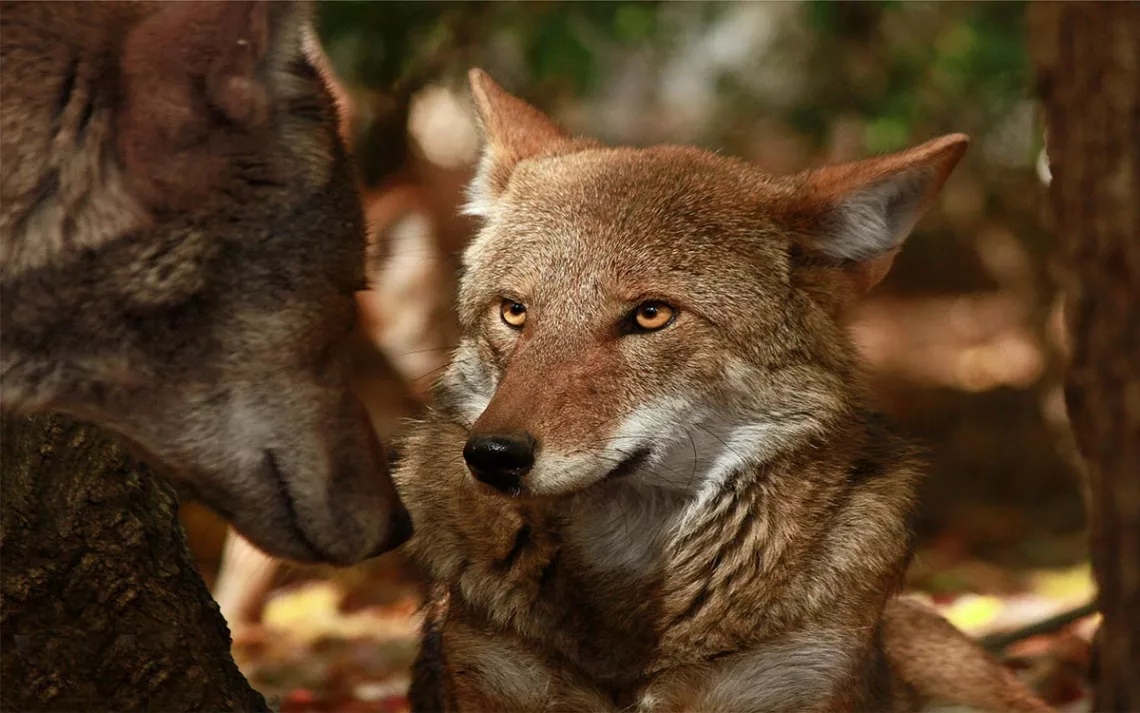Can the Red Wolf Survive Extinction a Second Time?
The U.S. Fish and Wildlife Service has no plan to save it

Some 20 red wolves live at the Wolf Conservation Center in New York. | Photos courtesy of Wolf Conservation Center
In 1980, the U.S. Fish and Wildlife Service removed the last 14 pure red wolves from the wild with plans to breed them in captivity and repopulate the landscape. Seven years later, four males and four females were released on the Albemarle-Pamlico Peninsula in North Carolina. After reaching a peak population of about 130 animals by 2006, gunshot and vehicular collisions have cut their numbers to just two dozen. The USFWS is now poised to abandon efforts to save them, this time with no plan for how, when, or where to reunite red wolves with their natural habitat.
Although 43 facilities hold a total captive population of 230 animals, the red wolf may soon gain the ignoble distinction of going extinct in the wild for a second time. “It’s heartbreaking,” said Maggie Howell, executive director of the Wolf Conservation Center in Salem, New York, with 20 of the cinnamon-colored animals in its care. “What sort of precedent does that set for future reintroduction programs?”
The red wolf, Canis rufus, is a smaller cousin of the gray wolf, with big ears and long legs. Adapted to warmer climates, they once roamed the eastern United States from Pennsylvania to Florida and Texas. They are protected under the Endangered Species Act (ESA), although the reintroduced animals in North Carolina are designated a nonessential, experimental population. But, as their numbers decline, the melodic, haunting howl that now rings out across the Alligator River National Wildlife Refuge may soon be silenced.
In a document outlining its proposed rule changes, the Fish and Wildlife Service envisages only a small group of fewer than 15 animals to be maintained on two federal parcels. The USFWS also acknowledges that the wolves would do what wolves do and leave the management area “on a fairly regular basis” to find mates and establish new territories. These wandering wolves would have no protection under the new regulations, which will allow unrestricted killing on private and non-federal land.
“This is abandonment of recovery in the wild,” said Sierra Weaver, an attorney with the Southern Environmental Law Center. Weaver’s team sued the USFWS in 2016 and won an injunction prohibiting the removal of wolves from private lands and barring the Fish and Wildlife Service from issuing kill permits. That injunction remains in place as of this writing. She sees the agency’s action as a bit of legal jujitsu.
“What the Fish and Wildlife Service has said to the court is, we're changing the rules, therefore the rules under which that injunction was issued no longer apply,” Weaver explained. She believes that at some point, management of the program shifted from science to politics. “A couple of powerful, individual landowners were able to overcome the incredible success of this program.”
Joseph Hinton is a researcher at the University of Georgia who has worked in the field with red wolves for 15 years. Speaking at a webinar for the Wolf Conservation Center, he said that around 2014, the USFWS did “a 180 on their position.” They put a halt to both wolf reintroductions and implementation of the red wolf adaptive management plan. In 2016, the Fish and Wildlife Service announced drastic changes to the red wolf recovery program, proposing to shrink protected areas by 90 percent.
That reduction, from 1.7 million to 204,000 protected acres, is included in the proposed USFWS rule change that it plans to implement by November 2018. In Hinton’s view, “The Fish and Wildlife Service is essentially setting the table to terminate the project in North Carolina.”
In a written response to questions, the USFWS stated that “various researchers” have looked at potential alternate sites, but they would be for a similarly designated nonessential, experimental population. Leopoldo Miranda, the USFWS’s assistant regional director for ecological services, wrote, “We fully support these efforts and will work with partners including state wildlife agencies and Native American tribes that may be interested in red wolf conservation.” According to the service’s most recent five-year status review, however, no alternate reintroduction sites have been evaluated.
That would leave just the captive population to carry on.
Can the red wolf survive indefinitely in zoos and conservation centers? “No,” said Howell emphatically. “It's the last resort. Recovery cannot happen in captivity alone.” Despite the best efforts of these facilities, “at some point it becomes artificial selection,” explained Hinton. The USFWS acknowledges that a captive population of at least 400 individuals is needed for long-term viability, almost double the existing number.
And that won’t be easy. “We're running out of room,” said Ben Prater, a field conservation director with Defenders of Wildlife. Returning from a recent meeting of the very people who manage the captive wolves, he told me, “Facilities need resources to expand and increase space, and that's one of the biggest constraints right now.” Miranda stated that the USFWS is working with these places “to develop and support strategies to increase capacity,” but gave no specifics.
Which brings up the issue of money. Howell said the Wolf Conservation Center gets no federal funds for participating in the red wolf recovery program. Their costs include providing enclosure space, feeding, and veterinary care. There’s also the cost of transportation when animals are moved to other facilities, often for “arranged marriages” to maintain genetic diversity. Rather than receiving money to support the revival of the red wolf, Howell said, “We are really in-kind donors to the program.”
Asked about funding, the USFWS said that $210,000 was budgeted each fiscal year from 2014 to 2016. But according to Chris Lasher at the North Carolina Zoo, the USFWS has, historically, only funded the original recovery center at Point Defiance Zoo & Aquarium in Washington.
Even if the Fish and Wildlife Service identifies alternate reintroduction sites, starting over elsewhere will be no easier than committing to making North Carolina work. Habitat throughout the red wolves’ traditional range in the Southeast is heavily fragmented, and there will likely be opposition wherever reintroduction is proposed. Coyotes, which have now colonized the eastern United States, present a problem when a thin population of red wolves makes it difficult to find a mate, resulting in interbreeding and hybridization.
“The service knows how to make this program work, and they can make it work again if they want to,” declared Weaver. A 2016 survey found that 73 percent of North Carolina voters favored red wolf recovery efforts, and 99 percent of 55,000 public comments received by the USFWS in 2017 were in support of the current recovery program.
Weaver has one more worry: a potential rewrite of the landmark Endangered Species Act. “It's really an open question what would happen if you change the law or if you change the regulations, both of which are in play at the moment.”
For almost 40 years, many people, many organizations, and the red wolves themselves have sacrificed, worked, and invested in the survival of this American species. They’ve brought it back once from extinction in the wild and created a conservation model for both the reintroduction of the gray wolf to Yellowstone and the Mexican gray wolf to Arizona and New Mexico.
“These wolves are really part of something bigger than they can possibly understand,” said Howell. “We just want to give these guys a chance.”
Array
Wolf Conservation Center curator Rebecca Bose gives a first health check to newborn red wolf pups.
 The Magazine of The Sierra Club
The Magazine of The Sierra Club



